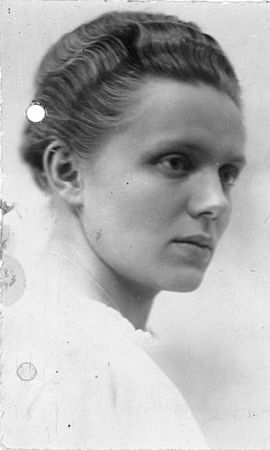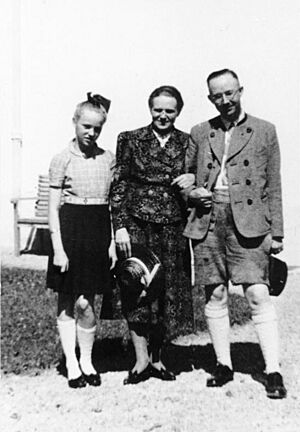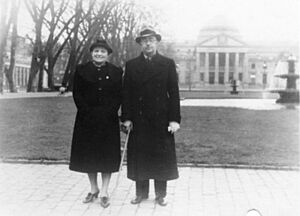Margarete Himmler facts for kids
Quick facts for kids
Margarete Himmler
|
|
|---|---|

Himmler in 1918
|
|
| Born |
Margarete Boden
9 September 1893 Goncarzewo near Bromberg, West Prussia, German Empire
|
| Died | 25 August 1967 (aged 73) |
| Other names | Margarete Siegroth Marga Himmler |
| Occupation | Nurse |
| Spouse(s) | |
| Children | Gudrun Burwitz |
Margarete Himmler (born Margarete Boden), also known as Marga Himmler (September 9, 1893 – August 25, 1967), was the wife of Heinrich Himmler. He was a very powerful leader in Nazi Germany.
Contents
Early Life and Nursing Career
Margarete Boden was born in Goncarzewo, a town near Bromberg (now Bydgoszcz, Poland). Her father, Hans Boden, was a landowner. Margarete had three sisters and one brother.
In 1909, she went to a high school for girls in Bromberg. During World War I, Margarete trained and worked as a nurse. After the war, she worked at a German Red Cross hospital.
Margarete was married once before meeting Heinrich Himmler, but that marriage was short and she had no children. With her father's help, she ran her own private nursing clinic in Berlin.
Marriage to Heinrich Himmler
Margarete met Heinrich Himmler in 1927 during one of his talks. They started writing letters to each other. Margarete was impressed by his writing style. She was seven years older than Heinrich.
Margarete and Heinrich both liked things to be neat and simple. They were also interested in herbal medicine. Margarete showed prejudice against Jewish people in her letters. For example, she wrote about a Jewish co-owner of her clinic, saying, "Those Jews are all the same!"
Heinrich and Margarete married in July 1928. Heinrich was worried about telling his parents because Margarete was older, divorced, and Protestant. None of Heinrich's family attended the wedding.
Their only child, Gudrun, was born on August 8, 1929. They also took in Gerhard von Ahe, a boy whose father was an SS officer who had died. Margarete sold her share of the clinic. She used the money to buy land near Munich, where they built a house.
Heinrich was often away for his work with the Nazi Party. Margarete managed their home and tried to raise animals, but it was not very successful. After the Nazis took power in 1933, the family moved to Munich, then to Gmund am Tegernsee in 1934. Heinrich later received a large house in Berlin as an official home.
Margarete joined the Nazi Party in 1928. She tried to be a good wife to a high-ranking Nazi leader. She would invite the wives of other SS leaders for coffee. However, she was not very popular among them. Some people described her as a "cool, hard woman" who complained a lot.
Heinrich Himmler later had a relationship with his secretary, Hedwig Potthast, starting in 1938. They had two children together. Margarete found out about this in 1941. She and Heinrich were already living separately. She decided to accept the situation for their daughter's sake.
Role During World War II
When World War II began, Margarete Himmler helped run a military hospital for the German Red Cross. By December 1939, she was in charge of Red Cross hospitals in the Berlin area. She traveled to places that Germany had taken over.
In March 1940, she visited German-occupied Poland. In her notes, she wrote about the people there, saying, "This Jewish rabble, Polacks, most of them don't look like human beings and the dirt is indescribable." She reached the rank of colonel in the German Red Cross for her work.
Heinrich Himmler was very close to his daughter Gudrun, whom he called Püppi ("dolly"). He called her often and visited whenever he could. Margarete and Heinrich Himmler last saw each other in April 1945 at their home in Gmund.
Life After the War

In 1945, Margarete and Gudrun left their home as Allied troops moved into the area. They were arrested in Italy in May 1945. They were held in different camps in Italy, France, and Germany.
During questioning, Margarete seemed unaware of her husband's official secrets. She was described as having a "small-town mentality." In September 1945, she was questioned again during the Nuremberg Trials. She and Gudrun were released in November 1946.
They found shelter at the Bethel Institution in Bielefeld, Germany. In 1947, a newspaper article said, "Widow of Heinrich Himmler Lives Like a Gentlewoman."
In 1948, Margarete was classified as a "lesser offender" by a process called Denazification. This process aimed to remove Nazi influence from society. She tried to change this classification, saying her early Nazi Party membership was only "nominal." She also said her high rank in the Red Cross was due to her long service since 1914.
Margarete argued that she stayed out of the public eye even though she was married to the Reichsführer-SS. However, the committee decided she likely supported the Nazi Party's goals and her husband's actions. Her lawyer argued that she should not be held responsible for her husband's actions.
In 1951, she was finally classified as a Mitläufer (Category IV), meaning she was a follower but not a main offender. This meant she was not held accountable for her husband's crimes. However, another process began because she and her daughter had benefited from her husband's rise to power.
In 1953, Margarete was classified as a "beneficiary of the Nazi regime." She was sentenced to 30 days of special work. She also lost her pension and the right to vote.
Gudrun left Bethel in 1952. From 1955, Margarete lived with her sister Lydia. Her adopted son Gerhard also lived with them. Margarete spent her final years with her daughter Gudrun in Munich. Gudrun remained very loyal to her father's memory.
Historians' View
Historians believe Margarete Himmler likely did not know about her husband's secret plans during the Nazi era. After the war, she said she had no knowledge of Nazi crimes. However, she remained a strong supporter of the Nazi ideas and was prejudiced against Jewish people. She benefited from the Nazi regime, even if she tried to stay away from its crimes.
See also
 In Spanish: Margarete Himmler para niños
In Spanish: Margarete Himmler para niños
- List of Nazi Party leaders and officials
- Women in Nazi Germany
Images for kids







